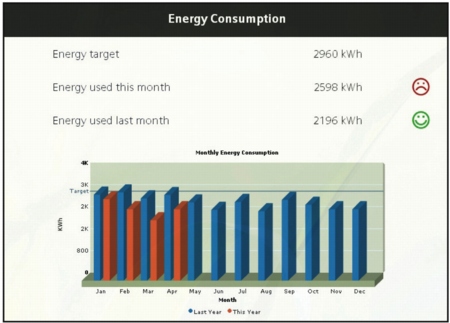The route to an energy-efficient building

Ian Ellis urges energy and facilities managers to adopt a long-term approach to building energy management systems (BEMS) to achieve maximum energy efficiencies in their buildings.
The arrival of an energy bill often represents a significant and growing cost for an organisation’s bottom line. As this is unlikely to change in the immediate future, it is important that businesses understand how they can tap into energy-efficiency savings to reduce the impact of their energy bill. Energy accounts for around 40% of the overall building operational costs, so it deserves attention.
The starting point for any effective energy-efficiency drive is to know where and how the building is using energy. The BEMS can be used to co-ordinate and manage the various energy-consuming systems within the building. One area which represents a significant proportion of energy consumption is the HVAC and lighting systems. In fact, lighting can represent up to 28% of a building’s total energy consumption. With such significant energy usage, there are tangible benefits to be had by making lighting as efficient as possible
Lighting is just one area, and it is important that energy and facilities managers take an overarching view of the energy consumption and efficiency within their building. This is where a BEMS such as the Desigo system from Siemens comes into its own. While this is a technological solution, it relies on the expertise and engagement of the people tasked with managing the building.
The benefits of a technologically sophisticated BEMS are already being realised by many businesses— for example, controlling various rooms to ensure optimum efficiency at all times. The functionality provided by room-occupancy and temperature sensors ensures rooms are not heated unnecessarily, and they can also synchronise with lighting systems so they go out when people leave the room.
By cutting corners on the capability of a system, organisations can miss out on significant savings. It is important to take a long-term approach to the investment in a system and consider the payback that can be achieved by more advanced features. The BS EN 15232 standard provides evidence of the effectiveness of BEMS in saving energy, it has all the facts and figures that any business director needs. The energy efficiency delivered by different levels of generic BEMS is compared, so that payback periods can be assessed for any investment in controls equipment.
Having accurate and effective demand control is also essential for the operation of an energy-efficient BEMS. It is therefore crucial that accurate parameters are established for the system so heating and lighting settings are appropriate for the environment, time of day and occupancy levels.
 |
| Achieving energy efficiency also requires positive behaviour such as switching off lights when they are not in use. |
Some organisations may feel that renewable-energy sources will help control energy consumption by providing additional generation. While this is certainly an approach to be applauded, it is important that these sources are controlled effectively and fully integrated into the BEMS.
Another area needing close attention is the maintenance and repair of the system which requires a certain level of knowledge and skill. It is important that the minor faults are not overlooked as this can mean the system is not working as efficiently as it should and can therefore make savings even harder to achieve.
In addition to technologically-advanced systems, staff engagement and knowledge is fundamental in the successful implementation of an energy-efficient BEMS. Those responsible for the operation of the BEMS on a daily basis should receive a thorough handover from the installer and ensure they are confident in all aspects of its operation. Only by having a comprehensive understanding of the system and its capabilities can operators ensure it offers optimum levels of performance.
Of course, the most efficient system in the world will not provide the savings it should if staff do not adopt energy-saving behaviour. By utilising technologies such as Siemens’ Green Building Monitor, organisations can demonstrate where energy is being used and where opportunities for potential savings are. Actual values of energy use can be displayed alongside target values. This can be used in public areas like receptions to provide a snapshot of how energy efficiency is being adopted throughout an organisation and can play a pivotal role in engaging staff. This should help the changes in behaviour required to become more efficient such as turning off equipment at the end of the day and switching off lights when not in use. It is simple to implement, and free measures such as these that can achieve energy savings of up to 10% by themselves.
Ultimately, any system is only as effective as its operator, so it is essential that energy and facilities managers are involved in the specification, design and installation of the BEMS and that they allow plenty of time to ensure they have the knowledge required to operate it effectively. By implementing these measures, organisations will be best-placed to achieve maximum savings through their BEMS, which will help to cut energy bills and the subsequent impact on the bottom line.
Ian Ellis is marketing manager for UK control products and systems with the Siemens Building Technologies division.









